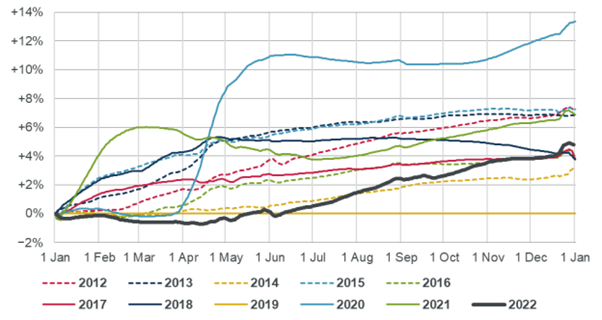Post-pandemic problems: why does UK mortality continue to be high?
10 Feb 2023
The Office for National Statistics recently published the data on registered deaths in England & Wales for the last week of 2022. This completes an interesting and worrying picture for the full year.
The Continuous Mortality Investigation (CMI) has been analysing this data as it has emerged throughout the year. The chart below is taken from its mortality monitor publication. It shows how mortality rates in each year compare to 2019, which represents a pre-pandemic benchmark. For the first half of the year, 2022 was below 2019 but in the second half of the year there was a significant number of excess deaths. This meant that mortality rates in 2022 finished at nearly 5% above 2019.
Cumulative standardised mortality rates for England & Wales compared with 2019
Source: CMI mortality monitor – week 52 of 2022
The data confirms that mortality has not yet reverted to pre-pandemic levels and suggests that a return to the normal levels of mortality improvement seen pre-pandemic may be some way off yet.
Were these excess deaths due to Covid-19?
The Office for Health Improvement and Disparities (OHID) produces a dashboard to enable the weekly deaths data to be looked into in more detail. (Note this only applies to England and uses a different measure of excess deaths than the CMI but this will not change the conclusions.)
The dashed purple lines represent an expected level of deaths had the pandemic not occurred. Covid related deaths are shown in orange.
Weekly registered deaths of all persons, England


Source: OHID excess mortality in England online dashboard.
Interestingly, although there was a high number of Covid related deaths throughout the year, they occurred primarily in the first half of the year. Mortality in total was in fact lower than the expected level at that stage. This chart suggests that the trend of increasing excess deaths seen in the second half of the year is driven by other causes.
Challenges with cardiovascular diseases
People suffering from cardiovascular disease are thought to be particularly impacted by the indirect effects of the pandemic. The British Heart Foundation referred to the pandemic as a “perfect storm” for heart disease in their July 2020 publication. The particular challenges they noted are:
- increased risk from Covid-19 for people with cardiovascular diseases,
- reduction in number of people seeking emergency healthcare,
- long waiting lists, and
- reduced access to community care.
Delving further into the deaths data using the OHID tool suggests that the challenges with cardiovascular disease are indeed having an impact at a population level.
The following chart shows the number of deaths for cardiovascular disease in excess of the expected level for that cause alone.
Weekly excess deaths by date of registration, all cardiovascular diseases, England
Source: OHID excess mortality in England online dashboard.
As can be seen from the above chart, there was a large number of excess deaths due to cardiovascular disease in the second half of the year, and so it appears that the challenges with cardiovascular disease go some way to explaining the overall figures for England & Wales.
One further cause that also shows a high level of excess deaths in the second half of the year, albeit lower than for cardiovascular, is acute respiratory infections. This coincides with the circulation of a serious strain of influenza in the latter parts of the year. The impact of this disease further explains the results at an aggregate level.
Weekly excess deaths by date of registration, acute respiratory infections, England
Source: OHID excess mortality in England online dashboard.
Other causes, including cancer and dementia and Alzheimer’s, do not generally show the same pattern.
The outlook for the short to medium term
The big question for insurers and reinsurers is how the situation might evolve over 2023 and beyond.
The NHS faces significant structural issues. These will be extremely difficult for the government to address and include:
- Lack of capital investment – the Health Foundation found that the UK would have invested £33bn more in health care between 2010 and 2019 if it had matched the investment (as a proportion of GDP) of other European countries.
- Staffing issues – according to NHS Vacancy Statistics around 10% of NHS roles are vacant, and there is a high level of absence due to sickness, with more than 1-in-5 citing anxiety, stress, or depression as a factor.
- Increased waiting lists – the backlog for consultant led elective care reached approximately 7 million people in 2022 according to the British Medical Association.
Unless progress is made in these areas it seems unlikely that mortality improvements will return to pre-pandemic levels in the short term.
We have advised a number of insurers and reinsurers on potential changes to their mortality trend assumptions for the short to medium term, providing our research alongside a range of scenarios for liability modelling. Please get in touch if you would like to hear more about how we can work together, or to have a more general conversation about this article.







0 comments on this post